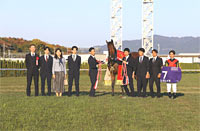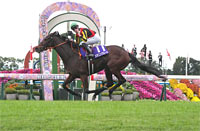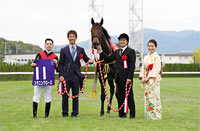Queen Elizabeth II Cup (G1) - Data Analysis
Race that determines autumn filly champion from runners across different generations
The Queen Elizabeth II Cup brings together 3-year-old fillies that have competed in the Fillies’ Triple Crown races and veteran fillies aged 4 and above. Over the last 10 years, 4-year-olds have won the race six times, while 3-year-olds and 5-year-olds have collectively secured two victories. As was also the case last year, the race will be held at Hanshin Racecourse this year. Let’s now look for some trends in results over the last 10 years.
Runners backed as 10th favorite or lower have consistently struggled
Looking at performances by runners over the last 10 years in terms of favoritism, we find that all winners were backed as 1st-7th favorite, with four winners being backed as 3rd favorite. Highly favored runners also achieved strong Top 3 ratios. Conversely, only one of the 84 runners backed as 10th favorite or lower finished in the Top 3. We should therefore assume that extremely poorly favored runners are highly unlikely to perform well. [Table 1]
[Table 1] Performance by favoritism (last 10 years)
| Favoritism |
Performance
[1st-2nd-3rd-4th or lower] |
Win ratio |
Top 2 ratio |
Top 3 ratio |
| 1st favorite |
2-3-2-3 |
20.0% |
50.0% |
70.0% |
| 2nd favorite |
1-1-1-7 |
10.0% |
20.0% |
30.0% |
| 3rd favorite |
4-0-2-4 |
40.0% |
40.0% |
60.0% |
| 4th favorite |
0-0-2-8 |
0% |
0% |
20.0% |
| 5th favorite |
1-1-2-6 |
10.0% |
20.0% |
40.0% |
| 6th-9th favorite |
2-4-1-33 |
5.0% |
15.0% |
17.5% |
| 10th favorite or lower |
0-1-0-83 |
0% |
1.2% |
1.2% |
Runners with fewer outings since the summer have the edge
Looking at performances by runners in terms of the number of outings since July of the same year, we observe that runners that had appeared in fewer races achieved a high Top 3 ratio. While the Queen Elizabeth II Cup was won by foreign runner Snow Fairy with five outings since July of the same year in 2011, by Rainbow Dahlia with three outings since July of the same year in 2012, and by Meisho Mambo with two outings since July of the same year in 2013, six of the seven winners since 2014 had only entered one race since July of the same year. Over the last five years, the three runners that had not appeared in a race since July of the same year all finished in third place. In other words, runners with fewer outings since the summer have had the edge in recent years [Table 2]
[Table 2] Performance by number of outings since July of same year (last 10 years)
| Number of races |
Performance
[1st-2nd-3rd-4th or lower] |
Win ratio |
Top 2 ratio |
Top 3 ratio |
| 4 or more |
1-0-0-10 |
9.1% |
9.1% |
9.1% |
| 3 |
1-2-2-28 |
3.0% |
9.1% |
15.2% |
| 2 |
2-6-2-62 |
2.8% |
11.1% |
13.9% |
| 1 |
6-2-3-39 |
12.0% |
16.0% |
22.0% |
| 0 |
0-0-3-5 |
0% |
0% |
37.5% |
Also check the number of G1 races contested in recent outings
Looking at performances by runners over the last 10 years in terms of the number of G1 races contested in their last three outings, we note that runners that had not contested such a race produced nine Top 3 finishers but had a Top 3 ratio of below 10%. Meanwhile, 21 runners that had contested a G1 race in their last three outings finished in the Top 3, and runners with a higher number of entries in G1 races in their last three outings achieved higher Top 3 ratios. The data therefore suggests we should focus on runners that have recently contested a high number of G1 races. [Table 3]
[Table 3] Performance by number of G1 races contested in previous three outings (last 10 years)
| Number of races |
Performance
[1st-2nd-3rd-4th or lower] |
Win ratio |
Top 2 ratio |
Top 3 ratio |
| 3 |
1-0-0-1 |
50.0% |
50.0% |
50.0% |
| 2 |
4-3-3-22 |
12.5% |
21.9% |
31.3% |
| 1 |
3-3-4-37 |
6.4% |
12.8% |
21.3% |
| 0 |
2-4-3-84 |
2.2% |
6.5% |
9.7% |
Watch favoritism in recent G1 and G2 races
Looking at performances by runners in terms of highest favoritism in a JRA G1 or G2 race contested in their last three outings, we note that runners that had been backed as 1st favorite in such races achieved a high Top 3 ratio of 50.0%. In addition, runners that had been backed as 2nd favorite and 3rd favorite achieved a higher Top 3 ratio than runners that had been backed as 4th favorite or lower. In other words, we should raise our expectations of runners that have recently entered a G1 or G2 race and were backed as 3rd favorite or higher in that race. [Table 4]
[Table 4] Performance by highest favoritism in JRA G1 or G2 race contested in last three outings (last 10 years)
| Highest favoritism |
Performance
[1st-2nd-3rd-4th or lower] |
Win ratio |
Top 2 ratio |
Top 3 ratio |
| 1st favorite |
3-2-6-11 |
13.6% |
22.7% |
50.0% |
| 2nd favorite |
1-2-2-14 |
5.3% |
15.8% |
26.3% |
| 3rd favorite |
2-1-0-11 |
14.3% |
21.4% |
21.4% |
| 4th favorite |
1-0-1-9 |
9.1% |
9.1% |
18.2% |
| 5th favorite |
0-1-0-11 |
0% |
8.3% |
8.3% |
| 6th-9th favorite |
2-3-0-25 |
6.7% |
16.7% |
16.7% |
| 10th favorite or lower |
0-1-0-20 |
0% |
4.8% |
4.8% |
No corresponding G1 or G2 race
entered in last three outings |
0-0-1-42 |
0% |
0% |
2.3% |
Overseas races entered in
last
three outings |
1-0-0-1 |
50.0% |
50.0% |
50.0% |
Seek out the winner!
Focus on winners’ previous race, finish, and time difference with winner
The five winners since 2016 had all contested a G1 or G2 race in their previous race and finished in the Top 3 of that race, having either won that race or been beaten to 2nd and 3rd with a time difference of 0.4s or less with the winner. When predicting the race winner, we should therefore focus on the grade of the previous race, the finish in that race, and the time difference with the winner in that race. [Table 5]
[Table 5] Winners’ performance by previous race and finish in that race (last five years)
| Year |
Winner |
Performance by previous race and finish
(time difference with winner) |
| 2016 |
Queens Ring |
G2 Fuchu Himba Stakes (Turf 1,800m) |
1st |
| 2017 |
Mozu Katchan |
G1 Shuka Sho (Turf 2,000m) |
3rd (0.2s) |
| 2018 |
Lys Gracieux |
G2 Fuchu Himba Stakes (Turf 1,800m) |
2nd (no time difference) |
| 2019 |
Lucky Lilac |
G2 Fuchu Himba Stakes (Turf 1,800m) |
3rd (0.3s) |
| 2020 |
Lucky Lilac |
G2 Sapporo Kinen (Turf 2,000m) |
3rd (0.4s) |
(Michio Kawano)
|


















